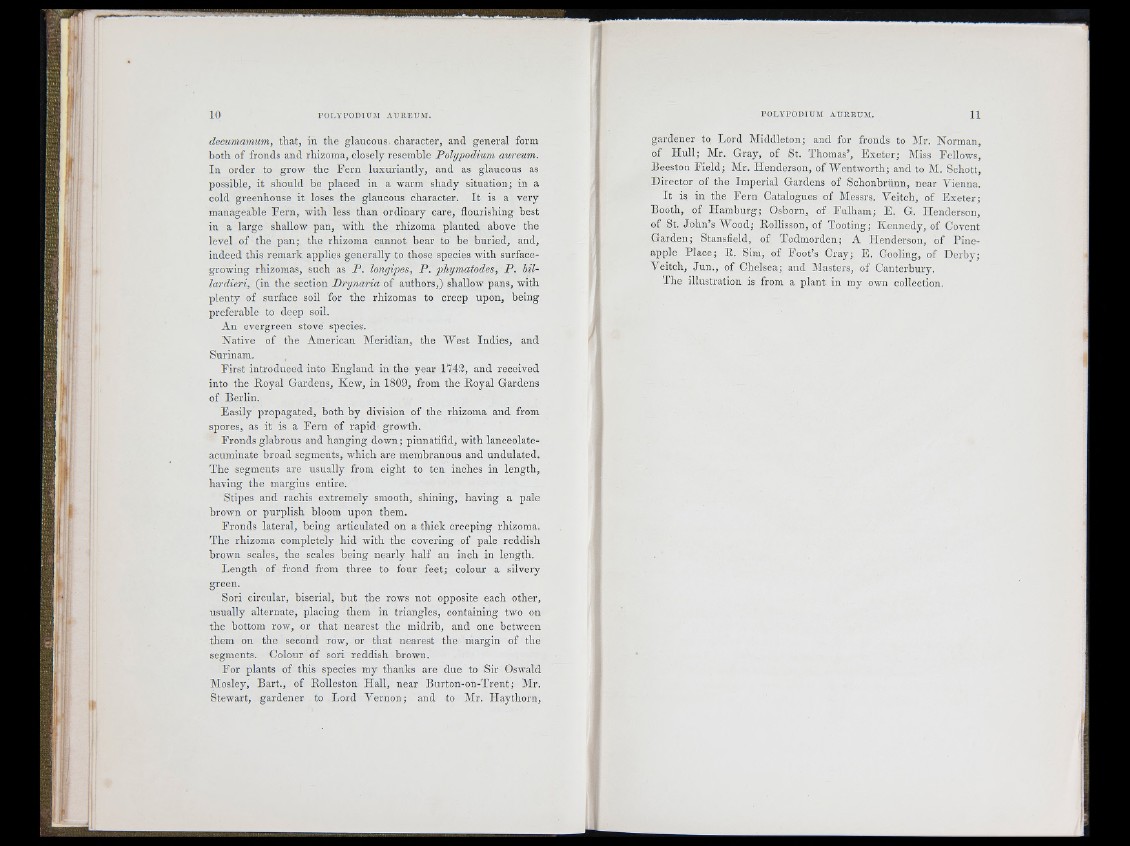
10 r o i .Y P o n i i i i t ADREuir.
decumamum, that, in the glaucous character, and general form
both of fronds and rhizoma, closely resemble Pohjpodium aureum.
In order to grow the F e rn lux u rian tly , and as glaucous as
possible, it should he placed in a warm shady situation; in a
cold greenhouse it loses the glaucous character. I t is a very
manageable F e rn , with less than ord in a ry care, flourishing best
in a large shallow pan, with the rhizoma planted above the
level of th e p an ; the rhizoma cannot bear to be buried, and,
indeed this remark applies generally to those species with surface-
growing rhizomas, such as P . longipes, P . p hymatodes, P . hil-
lardieri, (in the section D ryn a ria of authors,) shallow pans, with
p lenty of surface soil for th e rhizomas to creep upon, being
preferable to deep soil.
A n evergreen stove species.
Na tiv e of the American Me ridian, the W e s t In d ie s, and
Surinam.
F irs t introduc ed into E ng lan d in the year 1742, and received
into the E o y a l Gardens, Kew, in 1809, from the Roya l Gardens
of Berlin.
Easily propagated, b oth by division of the rhizoma and from
spores, as it is a F e rn of rap id growth.
Fro n d s glabrous and h anging down; pinnatifid, with lanceolate-
acuminate broad segments, which are membranous and undulated.
The segments are usually from eight to ten inches in length,
having the margins entire.
Stipes and rachis extremely smooth, shining, having a pale
brown or pu rp lish bloom upon them.
F ro n d s lateral, being articulated on a thick creeping rhizoma.
T h e rhizoma completely h id with the covering of pale reddish
brown scales, the scales being nearly h a lf an inch in length.
L en g th of frond from three to four feet; colour a silvery
green.
Sori circular, biserial, b u t the rows n o t opposite each other,
usua lly alternate, placing them in triangles, containing two on
th e bottom row, or th a t nearest the midrib, and one between
them on the second row, or th a t nearest the margin of the
segments. Colour of sori red d ish brown.
Fo r plants of this species my thanks are due to Sir Oswald
Mosley, B a rt., of Rolleston H a ll, n ear B u rto n -o n -T ren t; Mr.
Stewart, gardener to L o rd V e rn o n ; and to Mr. H ay th o rn ,
P O L Y P O D IU M A U K E U M . 11
gardener to L o rd .Middleton; and for fronds to Mr. Norman,
of H u ll; Mr. Gray, of St. Thomas’, E x e te r; Miss Fellows,
Beeston F ie ld ; Mr. Henderson, o f Wen two rth ; and to M. Schott,
D irector of the Imp e ria l Gardens of Schonbriinn, near Vienna.
I t is in the F e rn Catalogues of Messrs. Veitoh, of E x e te r;
Booth, of H am b u rg ; Osborn, of Fulh am ; E. G. Henderson,
of St. Jo h n ’s Wood; Rollisson, of T ooting; K en n ed y , of Covent
G a rd en ; Stansfield, of Todmorden; A Henderson, of P in e apple
Pla c e ; R. Sim, of F o o t’s Cray; E . Cooling, of D e rb y ;
Veitch, Ju n ., of Chelsea; and Masters, of Canterbury.
The illustration is from a plan t in my own collection.